Monday, April 30, 2012
Amid Rural Decay, Trees Take Root in Silos
(NYTimes) The sight is a familiar one along the dusty back roads of the Great Plains: an old roofless silo left to the elements along with decaying barns, chicken coops and stone homesteads.
This is the landscape of rural abandonment that
defines a region that has struggled with generations of exodus.
But increasingly there are unexpected signs of
rebirth. Many of these decrepit silos, once used to store feed for livestock,
now just hollow columns of cinder blocks, have through happenstance transformed
into unlikely nurseries for trees. Continued
Sunday, April 29, 2012
The Rock Island Line was a mighty fine line
Indeed, it may have been "the road to ride," but when hard times hit the railroads, some 40 odd years ago, the CRI&P found itself in real trouble. And unlike the Penn Central, it wasn't too big to fail, finally going belly up in one of the most convoluted bankruptcies in American history.
"The Rock" had two lines in New Mexico, one between Tucumcari and Dalhart, Texas, which still runs today, under the Union Pacific flag, and one that ran between Tucumcari and Glen Rio Texas (and points east), which was abandoned.
You can get a nice look at the abandoned line on old Route 66 between San Jon and Glen Rio, though it's a bumpy ride. Pictured is the only remaining trestle on this portion of the old right of way.
Thursday, April 26, 2012
Tuesday, April 24, 2012
Monday, April 23, 2012
Sunday, April 22, 2012
Saturday, April 21, 2012
Friday, April 20, 2012
Thursday, April 19, 2012
Wednesday, April 18, 2012
Mesalands 2: The One Hour Tour
Yesterday, I told you how to get a quick look at the Mesalands. Today, I'll tell you how to experience them up close, and it only takes an hour from the intestate. Just exit I-40 at Tucumcari and go to 1st Street, towards the center of town (away from I-40). First Street turns into State Road 104, you'll cross an overpass over the railroad tracks, it's the only one in town. In a few miles, you'll be in the Mesalands.
The first thing you'll see is two large mesas, one going east to west and one going north to south. Beyond those, the landscape opens up to reveal dozens of mesas. After a mere 20 miles, you'll have seen a lot of mesas and you can turn around and get back on the interstate, and if you have a little more time, you can keep going. Either way, you'll have seen some of the prettiest country in the west.
Tuesday, April 17, 2012
Mesalands
Tucumcari is surrounded by Mesas, but they can be hard to see in town. If you only have time for a quick look, drive to 10th Street and turn towards the wind turbine, it will take you up a hill with a nice view.
Sunday, April 15, 2012
The Ozark Trail

(wellingtontx.com) The Ozark Trails had nothing to do with cowboys or Indians, cattle drives or covered wagons. It was a good roads organization in the early days of automobile travel. The Ozark Trails Association was an organization of public-spirited good roads men to promote better roads and mark them for the convenience of travel. It did not make the roads. Businessmen supported the Ozark Trails to encourage tourism through their town knowing that people would stop to buy gasoline, food and other things.
Wellington was actually connected to the Ozark Trails from the east through Altus and Hollis, then Wellington and also from Chickasha, Hobart, Mangum and Vinson. The westward trails were through Amarillo, Tucumcari and Santa Rosa and through Childress, Plainview, Littlefield and Roswell. Continued
Photo: Ozark Trail Marker, Tucumcari, NM (drivetheost.com)
Saturday, April 14, 2012
Dinner at the VFW

Last night, we got dinner at the Tucumcari VFW post. It was very good and only $10 per person. They had steak (T-bone or sirloin), salad (garden or potato), beans, and dessert (cake or cobbler). Many organizations around here host various types of dinners. Somebody had a shrimp boil last night and week before last, the Methodists had an enchilada dinner. It's great fun, usually inexpensive, and all for good causes. It's one of the things I like about small town life.
The wind comes sweeping down the plain

When I moved west, my friend Kim came with me. She'd visited the area before, but never lived here. I really gave her the hard-sell, so when she read today's weather forecast and it said "Blowing Dust," she wasn't very happy with me. "You never mentioned blowing dust!" I answered with something snappy like "Uh, bluh, duh."
By a very happy coincidence, we received our first electric bill today. It was dramatically less than the electric rates back east, prompting Kim to exclaim, "Blow you turbines blow!" All's well that ends well.
Friday, April 13, 2012
Cordia Sloan Duke
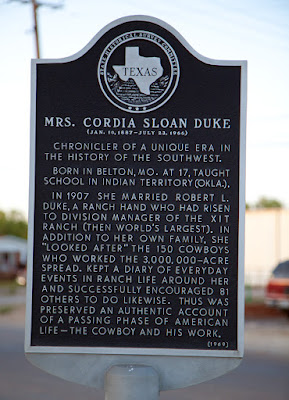
Marker reads:
Mrs. Cordia Sloan Duke - (Jan. 10, 1887 - July 23, 1966) Chronicler of a unique era in the history of the Southwest. Born in Belton, Mo. At 17, taught school in Indian Territory (Okla.) In 1907, she married Robert L. Duke, a ranch hand who had risen to division manager of the XIT Ranch (then world's largest). In addition to ther own family, she "looked after" the 150 cowboys who worked the 3,000,000-acre spread. Kept a diary of everyday events in ranch life around her and successfully encouraged 81 others to do likewise. Thus was preserved an authentic account of a passing phase of American life -- the cowboy and his work.
Wednesday, April 11, 2012
Tucumcari Train Station
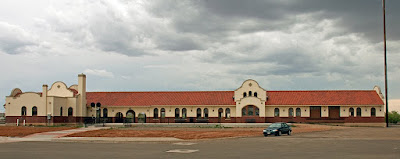
Tucumcari's railroad station was built in 1926 by the Rock Island Railroad at the point where it met the Southern Pacific. The station handled passengers, freight, and featured a restaurant. The station's exterior has recently been restored and is worth a visit. There is a small platform at the back of the breezeway for railfans to enjoy their hobby without getting in harm's way.

Monday, April 9, 2012
Empty Saddle Monument: Dalhart Texas

The Empty Saddle Monument is a tribute to Texas cowboys, particularly those of the XIT Ranch (pronounced X-I-T, not "zit"), a ranch that once spanned three million acres. The plaque reads as follows:
Great Texas ranch of international fame. Payment made in an 1882 contract for the construction of granite capitol building in Austin. As contractors, some out-of-state investors (headed by the wealthy Chicago merchants, John V. and Senator C. B. Farwell) built the largest state capitol in North America and received in payment 3,000,000-acres of land. The grant, 200 miles long and of varying widths (enclosed later by a 6,000-mile barbed wire fence), extended from near site of present Lubbock to the Oklahoma line 40 miles north of here. It included land in counties of Bailey, Castro, Cochran, Dallam, Deaf Smith, Hartley, Hockley, Lamb, Oldham, and Parmer. Trail Boss Abner Blocker delivered first herd to Buffalo Springs in 1885 and scratched the "XIT" in corral dust with boot heel to design famous brand. Although its land was parceled and sold, the XIT lives in Texas memories - especially here, 32 miles south of its Buffalo Springs headquarters. Dalhart holds an annual XIT reunion with rodeo and parade featuring a horse with an empty saddle, in honor of range riders of the past. Permanent tribute to XIT cowboys is this "empty saddle" monument, designed by western artist Bobby Dycke, dedicated in 1940.
Old Houses (#1&2)
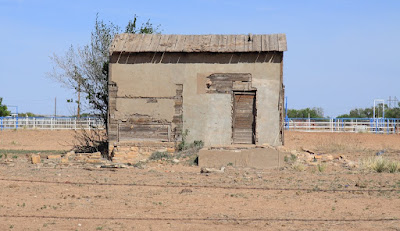
The southern plains are chock full of old houses and ranches, especially around towns such as Tucumcari and Clovis. Many are abandoned and many more are still occupied, or repurposed for storage. Unlike the more populated areas of the country, there is very little pressure or incentive to demolish old structures. If you like vernacular architecture, this region is a must. Here are just 2 examples, there will be more to come.
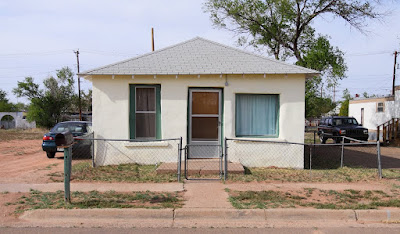
Sunday, April 8, 2012
Base Camp: Tucumcari
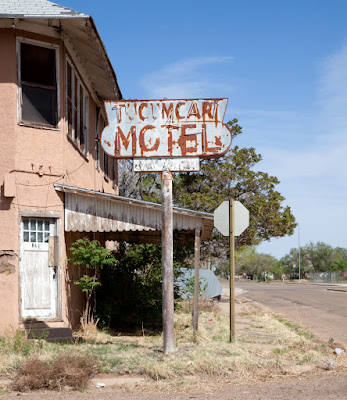
It's a big region and I've got to start somewhere. I chose Tucumcari because the cost of living is low, the people are friendly, and the place is rich in history. The town is usually associated with Route 66, but there's a lot more to it than that.Tucumcari started life as a "Hell on wheels" railroad boom town which acquired the name Six-Gun Siding (or Six-Shooter Siding), due to the lively activities of its early inhabitants. It was also known as Rag Town, because most everyone lived in tents. Around the same time, the area was open to homesteaders. It is also in the midst of the Mesalands, breaking up the sometimes featureless areas of the High Plains. I'll be exploring all these aspects of the region, and more, in the months to come, mostly in pictures, with a little text thrown in. I hope you enjoy it.
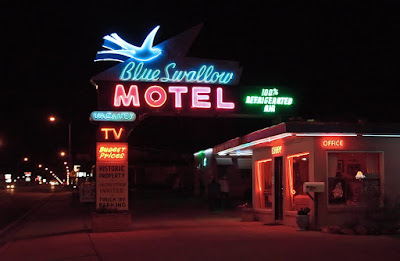
Subscribe to:
Posts (Atom)





















